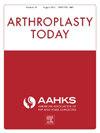Robotic Arm–Assisted Total Knee Arthroplasty Results in Smaller Femoral Components and Larger Tibial Baseplates Than the Manual Technique
IF 1.5
Q3 ORTHOPEDICS
引用次数: 0
Abstract
Background
Robotic systems for total knee arthroplasty (TKA) may utilize computed tomography three-dimensional modeling and intraoperative ligamentous balancing data to assist surgeons with implant size and position. This study evaluated the effect of such robotic systems on implant selection.
Methods
We reviewed 645 TKAs performed with a single prosthetic design at 2 academic medical centers between 2016 and 2022. A robotic system was utilized in 304 TKAs, 341 were conventionally instrumented. Implant sizing was compared between cohorts. Multivariate analyses assessed for confounding and effect modification on the basis of demographics.
Results
The 2 cohorts exhibited no significant differences in age (P = .33), weight (P = .29), or race (P = .24). The robotic-arm cohort had fewer women (58.9% vs 66.7% P = .04) and was taller on average (66.3 in vs 65.0 in P < .001). Mean polyethylene liner thickness was larger in the manual cohort (10.3 robotic and 10.6 manual; P < .00). On multivariate analysis, robotic-arm TKAs had larger tibial components (P < .001) and smaller femoral components (P = .017).
Conclusions
Robotic-arm assisted TKA with computed tomography–based three-dimensional planning was associated with a larger mean tibial component size and a smaller mean femoral component size when compared to conventionally instrumented TKAs. Observed differences likely reflect differences in the data informing implant size selection; effects on clinical outcomes warrant further study.
与手动技术相比,机器人手臂辅助全膝关节置换术可获得更小的股骨组件和更大的胫骨基板
背景用于全膝关节置换术(TKA)的机器人系统可利用计算机断层三维建模和术中韧带平衡数据来协助外科医生确定植入物的大小和位置。本研究评估了此类机器人系统对植入物选择的影响。方法我们回顾了2016年至2022年期间在两家学术医疗中心使用单一假体设计进行的645例TKA手术。304例TKAs使用了机器人系统,341例使用了传统器械。对不同组群的假体尺寸进行了比较。结果两个队列在年龄(P = .33)、体重(P = .29)或种族(P = .24)方面无显著差异。机器人手臂队列中女性较少(58.9% vs 66.7% P = .04),平均身高较高(66.3 英寸 vs 65.0 英寸 P < .001)。手动组的平均聚乙烯衬垫厚度更大(机器人为 10.3 英寸,手动为 10.6 英寸;P < .00)。结论与传统的器械辅助 TKA 相比,基于计算机断层扫描三维规划的机器人臂辅助 TKA 的胫骨组件平均尺寸较大,股骨组件平均尺寸较小。观察到的差异可能反映了选择植入物尺寸的数据差异;对临床结果的影响值得进一步研究。
本文章由计算机程序翻译,如有差异,请以英文原文为准。
求助全文
约1分钟内获得全文
求助全文
来源期刊

Arthroplasty Today
Medicine-Surgery
CiteScore
2.90
自引率
0.00%
发文量
258
审稿时长
40 weeks
期刊介绍:
Arthroplasty Today is a companion journal to the Journal of Arthroplasty. The journal Arthroplasty Today brings together the clinical and scientific foundations for joint replacement of the hip and knee in an open-access, online format. Arthroplasty Today solicits manuscripts of the highest quality from all areas of scientific endeavor that relate to joint replacement or the treatment of its complications, including those dealing with patient outcomes, economic and policy issues, prosthetic design, biomechanics, biomaterials, and biologic response to arthroplasty. The journal focuses on case reports. It is the purpose of Arthroplasty Today to present material to practicing orthopaedic surgeons that will keep them abreast of developments in the field, prove useful in the care of patients, and aid in understanding the scientific foundation of this subspecialty area of joint replacement. The international members of the Editorial Board provide a worldwide perspective for the journal''s area of interest. Their participation ensures that each issue of Arthroplasty Today provides the reader with timely, peer-reviewed articles of the highest quality.
 求助内容:
求助内容: 应助结果提醒方式:
应助结果提醒方式:


